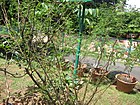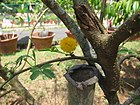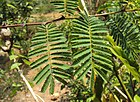Note: This is a project under development. The articles on this wiki are just being initiated and broadly incomplete. You can Help creating new pages.
Senegalia catechu - Khadira
Senegalia catechu is a deciduous thorny tree which grows up to 15 m in height.
Contents
- 1 Uses
- 2 Parts Used
- 3 Chemical Composition
- 4 Common names
- 5 Properties
- 6 Habit
- 7 Identification
- 8 List of Ayurvedic medicine in which the herb is used
- 9 Where to get the saplings
- 10 Mode of Propagation
- 11 How to plant/cultivate
- 12 Commonly seen growing in areas
- 13 Photo Gallery
- 14 References
- 15 External Links
Uses
chronic catarrh, chronic diarrhoea, dysentery, foliage, Skin eruptions.
Parts Used
Chemical Composition
Hydroxybenzoic acid, kaempferol, quercetin, 3,4',7-trihydroxyl-3', 5-dimethoxyflavone, catechin, epicatechin, afzelechin, epiafzelechin, mesquitol, ophioglonin, aromadendrin, and phenol[1]
Common names
| Language | Common name |
|---|---|
| Kannada | kaachu, kadira |
| Hindi | gayatrin, khair |
| Malayalam | karintaali |
| Tamil | cenkarungali |
| Telugu | khadiramu |
| Marathi | NA |
| Gujarathi | NA |
| Punjabi | NA |
| Kashmiri | NA |
| Sanskrit | gayatrin |
| English | Cutch Tree, black catechu |
Properties
Reference: Dravya - Substance, Rasa - Taste, Guna - Qualities, Veerya - Potency, Vipaka - Post-digesion effect, Karma - Pharmacological activity, Prabhava - Therepeutics.
Dravya
Rasa
Tikta (Bitter), Kashaya (Astringent)
Guna
Laghu (Light), Ruksha (Dry)
Veerya
Sheeta (cold)
Vipaka
Katu (Pungent)
Karma
Kapha, Pitta
Prabhava
Habit
Identification
Leaf
| Kind | Shape | Feature |
|---|---|---|
| Simple | Leaves 2-pinnate, pinnae 40-80, leaflets 60-100, small ligulate |
Flower
| Type | Size | Color and composition | Stamen | More information |
|---|---|---|---|---|
| Unisexual | 2-4cm long | Yellow | 5-20 | Flowers small, pale yellow or white in cylindrical axillary spikes |
Fruit
| Type | Size | Mass | Appearance | Seeds | More information |
|---|---|---|---|---|---|
| General | 7–10 mm | clearly grooved lengthwise, Lowest hooked hairs aligned towards crown | {{{6}}} |
Other features
List of Ayurvedic medicine in which the herb is used
- Vishatinduka Taila as root juice extract
Where to get the saplings
Mode of Propagation
How to plant/cultivate
A plant for sub-tropical to tropical areas, tolerating a minimum temperature of about 7c. It is especially common in the drier regions, but can also be grown in the more humid climates of South-East Asia at elevations from sea-level to about 1,500 metres[3]
Commonly seen growing in areas
On well drained soil, Open, drier areas, sandy soils.
Photo Gallery
References
External Links
- Ayurvedic Herbs known to be helpful to treat chronic catarrh
- Ayurvedic Herbs known to be helpful to treat chronic diarrhoea
- Ayurvedic Herbs known to be helpful to treat dysentery
- Ayurvedic Herbs known to be helpful to treat foliage
- Ayurvedic Herbs known to be helpful to treat Skin eruptions
- Herbs with Flowers used in medicine
- Herbs with Leaves used in medicine
- Herbs with common name in Kannada
- Herbs with common name in Hindi
- Herbs with common name in Malayalam
- Herbs with common name in Tamil
- Herbs with common name in Telugu
- Herbs with common name in Sanskrit
- Herbs with common name in English
- Habit - Deciduous Tree
- Index of Plants which can be propagated by Seeds
- Index of Plants which can be propagated by Cuttings
- Herbs that are commonly seen in the region of On well drained soil
- Herbs that are commonly seen in the region of Open, drier areas
- Herbs that are commonly seen in the region of sandy soils
- Herbs






